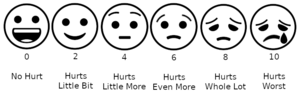Faces Pain Scale - Revised
Original Editor - Blessed Denzel Vudzijena
Top Contributors - Blessed Denzel Vudzijena, Lucinda hampton, Chelsea Mclene and Melissa Coetsee
Objective[edit | edit source]
Pain examination in pediatric clients is not easy to analyze or understand just like in adults, due to varying pain experiences and limits, and also due to diverse social and cognitive developmental milestones[1]. The Faces Pain Scale-Revised (FPS-R) is a measure of pain intensity that was modified from the Faces Pain Scale (Wong-Beker)[2] to facilitate a more acceptable 0 to 10 criterion in scoring pain sensation. The scale shares an intimate straightforward relationship with the visual analog scale (VAS) throughout the 4 to 16 years age group[3] and is relatively simple to administer. Unlike its predecessor, the FPS-R's lack of smiles and tears is an advantage as the grimacing faces represent a more accurate expression of pain.
Intended Population[edit | edit source]
School-aged/Children older than 4 years old
Method of Use[edit | edit source]
According to the International Association For The Study Of Pain (IASP)[4], FPS-R is a self-reported measure of pain intensity, that requires little time and very few instruments like the photocopied faces to administer. The clinician scores the chosen face 0, 2, 4, 6, 8, or 10, counting left to right from the six series of faces. Take care not to use words like "happy" and '"sad" as the scale is intended to measure how children feel inside, rather than how their face looks. Below is the interpretation of the scores :
0 =No Pain
2 = Mild
4 = Nagging
6 =Miserable
8 =Intense
10 = Worst
Evidence[edit | edit source]
Reliability[edit | edit source]
In a study that assessed pre and post analgesia administration pain scores the indices of relative reliability showed a good agreement between the test and retest for the scale, 0.76 (95% CI 0.72-0.80).[5]
Validity[edit | edit source]
In the same study that assessed pre and post analgesia administration pain scores, FPS-R was compared against the VAS for construct validity and Pearson correlations between the two were found to be r = 0.78 at 60 minutes after medication administration, showing positive and strong correlations[5].
Responsiveness[edit | edit source]
The scale demonstrated good responsiveness to change in the study[5] that assessed pre and post analgesia administration pain scores. The mean pain scores pre-analgesia were SD = 1.82; median: 6.0; IQR: 4.0-6.0 and after analgesic administration the mean pain scores were SD = 2.31; median: 4.0; IQR: 2.0-6.0. The mean differences in pain scores were significantly lower 60 minutes after the administration of the medication (mean = −1.61, SD = 2.00, P < 0.0001) which suggests high responsiveness of the scale to pain relief.
Links[edit | edit source]
You can download the tool here for free.
References[edit | edit source]
- ↑ Emmott AS, West N, Zhou G, Dunsmuir D, Montgomery CJ, Lauder GR, von Baeyer CL. Validity of Simplified Versus Standard Self-Report Measures of Pain Intensity in Preschool-Aged Children Undergoing Venipuncture. J Pain. May 2017;18(5):564-573.
- ↑ Garra G, Singer A, Taira B, Chohan J. Validation of the Wong-Baker FACES Pain Rating Scale in Pediatric Emergency Department Patients. Academic Emergency Medicine. 2010 Jan; 17 (1): 50-54
- ↑ Tsze DS, Hirschfeld G, Dayan PS, Bulloch B, von Baeyer CL. Defining No Pain, Mild, Moderate, and Severe Pain Based on the Faces Pain Scale-Revised and Color Analog Scale in Children With Acute Pain. Pediatric Emergency Care. Aug 2018;34(8):537-544.
- ↑ International Association For the Study of Pain. Faces Pain scale - revised. Available from https://www.iasp-pain.org/resources/faces-pain-scale-revised/ (accessed 21 Apr 2022)
- ↑ 5.0 5.1 5.2 Le May S, Ballard A, Khadra C, Gouin S; Plint, A; Villeneuve, E. Comparison of the psychometric properties of 3 pain scales used in the pediatric emergency department: Visual Analogue Scale, Faces Pain Scale-Revised, and Colour Analogue Scale. PAIN. 2018 Aug; 159(8): 1508-1517







